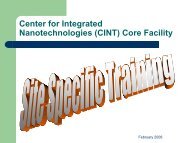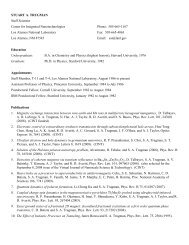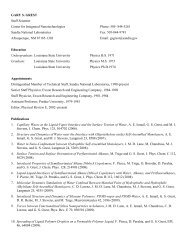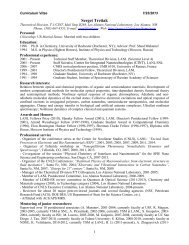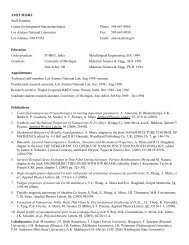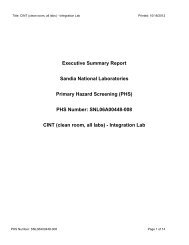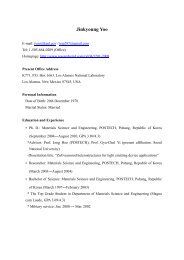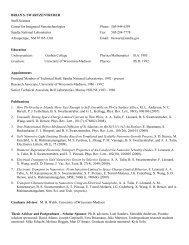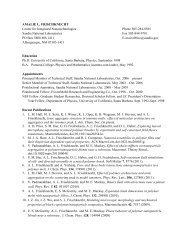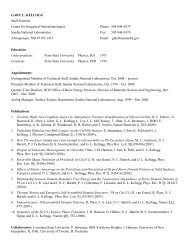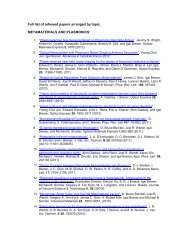2011 Annual Report - Center for Integrated Nanotechnologies - Los ...
2011 Annual Report - Center for Integrated Nanotechnologies - Los ...
2011 Annual Report - Center for Integrated Nanotechnologies - Los ...
You also want an ePaper? Increase the reach of your titles
YUMPU automatically turns print PDFs into web optimized ePapers that Google loves.
Nanophotonics & Optical Nanomaterials Thrust<br />
<strong>Los</strong> Alamos scientists detect and track single molecules with nanoscale carbon cylinders<br />
LOS ALAMOS, New Mexico, January 10, 2012—Many physical<br />
and chemical processes necessary <strong>for</strong> biology and chemistry<br />
occur at the interface of water and solid surfaces. Researchers at<br />
The <strong>Center</strong> <strong>for</strong> <strong>Integrated</strong> <strong>Nanotechnologies</strong> publishing in Nature<br />
Nanotechnology have now shown that semiconducting carbon<br />
nanotubes—light emitting cylinders of pure carbon—have the<br />
potential to detect and track single molecules in water.<br />
Using high-speed microscopic imaging, they found that nanotubes<br />
could both detect and track the motion of individual<br />
molecules as they bombard the surface at the water interface.<br />
Traditional techniques to investigate molecules on surfaces cannot<br />
be used in water because the study requires low-pressure atmospheres<br />
such as one finds in space. The team is hopeful that<br />
their work will lead to practical, nanotube-based, single-molecule<br />
detectors in aqueous biological and chemical environments.<br />
Molecular motion and attachment to surfaces is important <strong>for</strong><br />
driving chemistry that ranges from the production of ammonia<br />
on metal to the enzymatic oxidation of glucose. The attachment<br />
takes place through sporadic motion followed by a collision with<br />
the surface to which the molecule sticks. Molecules can then<br />
move along the surface where they can collide with other molecules<br />
and undergo chemical reactions.<br />
In traditional “surface science” experiments these processes are<br />
imaged in a vacuum where other molecular species from the<br />
air cannot blur the image. In solutions such as water, there has<br />
been no way to do this directly. Consequently, researchers have<br />
been searching <strong>for</strong> a material that can be used in water to detect<br />
individual molecules <strong>for</strong> surface-science applications.<br />
Artist’s concept of nanotubes on the liquid surface. Image from <strong>Los</strong> Alamos National<br />
Laboratory.<br />
Inspired by this challenge a team of scientists<br />
(Jared Crochet, Juan Duque, Jim Werner,<br />
and Steve Doorn) at LANL’s <strong>Center</strong> <strong>for</strong><br />
<strong>Integrated</strong> <strong>Nanotechnologies</strong> explored using<br />
light-emitting carbon nanotubes as detectors.<br />
With techniques developed by others,<br />
the team used soap and water to stabilize<br />
the nanotubes where they could be imaged<br />
directly with a high-speed video camera.<br />
When illuminated with laser light these<br />
tubes shine brightly, like long glow sticks.<br />
When the glowing nanotubes are exposed<br />
in water to different chemicals, the researchers<br />
saw that certain spots of the tube<br />
would briefly go dim as the molecules bombarded<br />
the surface. This allowed them to<br />
determine how effectively certain molecules<br />
would stick to the surface. The researchers<br />
were also able to track the motion of<br />
molecules as they moved along the surface.<br />
The team is now examining how chemical<br />
reactions proceed on nanotube surfaces to<br />
better understand chemistry at the water<br />
interface <strong>for</strong> biological and chemical applications.<br />
Article from a LANL Press Release<br />
Left to right: CINT Postdoc Jared Crochet, User Juan Duque, & Scientist Steve Doorn<br />
25





